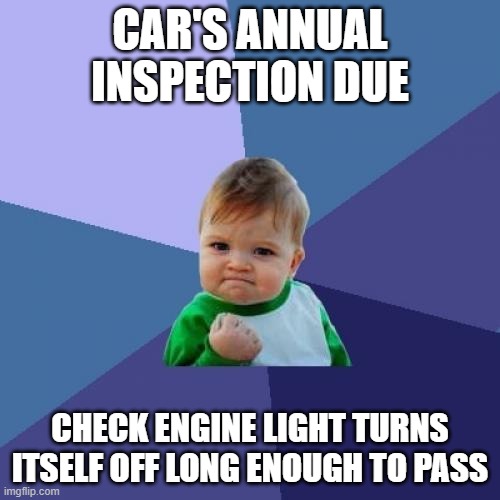Driving down the highway, the dreaded sight of the check engine light flashing on can send shivers down any driver’s spine. It’s like a warning beacon, signaling that something is amiss with your vehicle. But what happens when the check engine light turns off and on? Is it a sign of relief or should you remain vigilant?

Image: www.mercedes-benz-newmarket.ca
In this comprehensive guide, we will delve into the complexities of the check engine light, its significance, and the reasons why it might be behaving erratically. Armed with this knowledge, you will be better equipped to make informed decisions about your vehicle’s health.
Understanding the Check Engine Light
The check engine light, also known as the Malfunction Indicator Lamp (MIL), is a vital diagnostic tool built into all modern vehicles. When the light illuminates, it indicates that the vehicle’s Engine Control Module (ECM) has detected an anomaly in the engine’s performance or emission control systems.
The check engine light can be triggered by a wide range of issues, from minor sensor malfunctions to severe mechanical problems. Some common causes include loose gas caps, faulty oxygen sensors, catalytic converter failures, and engine misfires.
Why Does the Check Engine Light Turn Off and On?
When the check engine light turns off and on, it could be due to a number of factors:
- Intermittent Problem: The issue that triggered the check engine light may be intermittent, meaning it comes and goes. This could be caused by a loose electrical connection or a failing sensor.
- Temporary Reset: If you clear the check engine light using a code reader or by disconnecting the battery, it may turn off temporarily. However, if the underlying problem persists, the light will eventually illuminate again.
- ECM Malfunction: In rare cases, the check engine light may turn off and on due to a malfunction in the ECM. This is a more serious issue that requires professional attention.
What to Do When the Check Engine Light Turns Off and On
If the check engine light turns off and on, it’s important to take the following steps:
- Monitor the Light: Pay attention to the frequency and duration of the light’s illumination. If the light stays on for extended periods or flashes erratically, it’s likely indicating a more serious problem.
- Get a Code Reading: Use a code reader or have a mechanic perform a code scan to retrieve any diagnostic trouble codes (DTCs) that may have been stored in the ECM.
- Inspect the Vehicle: Perform a thorough visual inspection of the vehicle, looking for any obvious signs of problems, such as leaking fluids or loose connections.
- Consult a Mechanic: If you’re unable to diagnose the problem yourself, it’s highly recommended to consult a certified mechanic for further evaluation and repair.
- Don’t Ignore the Light: Ignoring the check engine light can lead to more serious problems down the road. It’s important to address issues promptly to minimize costly repairs.
- Use a Quality Code Reader: Invest in a reliable code reader that can accurately retrieve and interpret diagnostic trouble codes.
- Document the Codes: Keep a record of any DTCs that are displayed. This information can be helpful for both diagnosing the problem and communicating with a mechanic.
- Consider the Context: When interpreting DTCs, consider the vehicle’s specific make, model, and driving conditions to narrow down the possible causes.
- Don’t Be Afraid to Seek Help: If you’re not comfortable diagnosing or repairing the problem yourself, don’t hesitate to consult a certified mechanic.
-
Q: Is it safe to drive with the check engine light flashing?
A: It’s generally not recommended to drive with the check engine light flashing, as it may indicate a serious problem. It’s best to pull over safely and contact a mechanic.
-
Q: Can I clear the check engine light by disconnecting the battery?
A: Disconnecting the battery will temporarily clear the check engine light, but it will not fix the underlying problem. The light will likely illuminate again once the ECM detects the issue.
-
Q: What are some common causes of the check engine light turning off and on?
A: Some common causes include intermittent sensor issues, loose gas caps, faulty oxygen sensors, and engine misfires.
-
Q: What is the best way to diagnose a check engine light problem?
A: The best way to diagnose a check engine light problem is to retrieve and interpret the diagnostic trouble codes using a code reader or have a mechanic perform a diagnostic scan.
-
Q: What are some precautions I can take to avoid check engine light issues?
A: Some precautions include regular maintenance, using quality fuels and fluids, and driving conservatively to minimize engine wear and tear.

Image: imgflip.com
Tips for Addressing Check Engine Light Issues
Here are some expert tips to help you address check engine light issues:
Frequently Asked Questions About Check Engine Light Turning Off and On
Check Engine Light Turns Off And On
Conclusion
The check engine light is a valuable diagnostic tool that can help drivers identify and address potential problems with their vehicles. Understanding why the check engine light turns off and on is crucial for making informed decisions about the health of your car.
By following the tips and advice outlined in this article, you can effectively manage check engine light issues and keep your vehicle running smoothly and efficiently. Are you interested to know more about this topic?


/GettyImages-1303637-two-way-mirror-57126b585f9b588cc2ed8a7b-5b8ef296c9e77c0050809a9a.jpg?w=740&resize=740,414&ssl=1)


